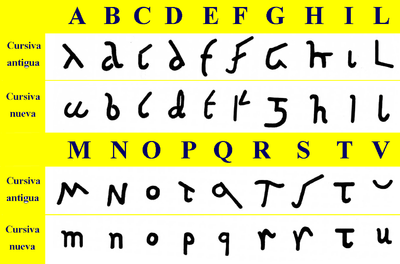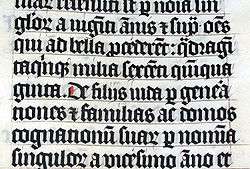Roman cursive

Roman cursive (or Latin cursive) is a form of handwriting (or a script) used in ancient Rome and to some extent into the Middle Ages. It is customarily divided into old (or ancient) cursive, and new cursive.
Old Roman cursive
Old Roman cursive, also called majuscule cursive and capitalis cursive, was the everyday form of handwriting used for writing letters, by merchants writing business accounts, by schoolchildren learning the Latin alphabet, and even by emperors issuing commands. A more formal style of writing was based on Roman square capitals, but cursive was used for quicker, informal writing. It was most commonly used from about the 1st century BC to the 3rd century AD, but it probably existed earlier than that. In the early 2nd century BC, the comedian Plautus, in Pseudolus, makes reference to the illegibility of cursive letters:
Calidorus: Cape has tabellas, tute hinc narrato tibi quae me miseria et cura contabefacit.
Pseudolus: Mos tibi geretur. Sed quid hoc, quaeso?
Pseudolus: An, opsecro hercle, habent quas gallinae manus? Nam has quidem gallina scripsit.
Calidorus: Quid est?
Pseudolus: Ut opinor, quaerunt litterae hae sibi liberos: alia aliam scandit.
Calidorus: Ludis iam ludo tuo?
Pseudolus: Has quidem pol credo nisi Sibylla legerit, interpretari alium posse neminem.
Calidorus: Cur inclementer dicis lepidis litteris lepidis tabellis lepida conscriptis manu?
Calidorus: Take these letters, then tell yourself what misery and concern are wasting me away.
Pseudolus: I will do this for you. But what is this, I ask?
Pseudolus: By Hercules I beg you, do even hens have hands like these? For indeed a hen wrote these letters.
Calidorus: What's wrong?
Pseudolus: In my opinion, these letters are seeking children for themselves: one mounts the other.
Calidorus: Are you mocking me with your teasing?
Pseudolus: Indeed, by Pollux I believe that unless the Sibyl can read these letters, nobody else can understand them.
Calidorus: Why do you speak harshly about these charming letters and charming tablets, written by a charming hand?
(Plautus, Pseudolus, 21–30)

vobis · videtur · p · c · décernám[us · ut · etiam]
prólátis · rebus iis · iúdicibus · n[ecessitas · iudicandi]
imponátur qui · intrá rerum [· agendárum · dies]
incoháta · iudicia · non · per[egerint · nec]
defuturas · ignoro · fraudes · m[onstrósa · agentibus]
multas · adversus · quas · exc[ogitáuimus]...
Old Roman cursive is very difficult to read for modern people used to the current cursive forms of the 'Latin' script, which have evolved beyond recognition. The script uses many ligatures, and some letters are unrecognizable – "a" looks like an uncial "a", but with the left stroke still straight, "b" and "d" are hard to distinguish, "e" is a full height letter (like the "s"), "p" and "t" are very similar, and "v" is written above the baseline, resembling an inverted chevron.[1]
New Roman cursive
New Roman cursive, also called minuscule cursive or later Roman cursive, developed from old Roman cursive. It was used from approximately the 3rd century to the 7th century, and uses letter forms that are more recognizable to modern readers; "a", "b", "d", and "e" have taken a more familiar shape, and the other letters are proportionate to each other rather than varying wildly in size and placement on a line. These letter forms were in part the basis for the medieval script known as Carolingian minuscule, which was developed at Aachen and in Tours in the 9th century and propagated throughout Charlemagne's empire in a deliberate attempt to unify handwriting, and whose revival in the Renaissance, after it had evolved into the relatively illegible blackletter and fallen out of use, forms the basis of our modern lowercase letters. The uncial and half-uncial scripts also most likely developed from this script; "a", "g", "r", and "s" are particularly similar.[2]
According to Jan-Olaf Tjäder, new Roman cursive influenced the development of not only uncial, but of all the other scripts used in the Middle Ages.[3][4] Gaelic type is an example of a later usage of uncial.
See also
Notes
- ↑ Oxford, Scripts at Vindolanda page 2 page 3
- ↑ Oxford, Scripts at Vindolanda: Historical context.
- ↑ Jan-Olaf Tjäder, (Lund, 1955).
- ↑ Oxford, Vindolanda Tablets
References
- Jan-Olaf Tjäder, Die nichtliterarischen lateinischen Papyri Italiens aus der Zeit 445–700 (Lund, 1955).
- Staff, Vindolanda Tablets on line, Centre for the Study of Ancient Documents and the Academic Computing Development Team at Oxford University.
Further reading
- 'Manual of Latin Palaeography' (A comprehensive PDF file containing 82 pages profusely illustrated, June 2014).
- Staff, Latin cursive presented by the University of Michigan Papyrus Collection
- Staff, Vindolanda: Roman documents discovered, Current Archaeology, a World Wide Web article, based on a fuller accounts in Current Archaeology Nos. 116, 128. 132 and 153.
